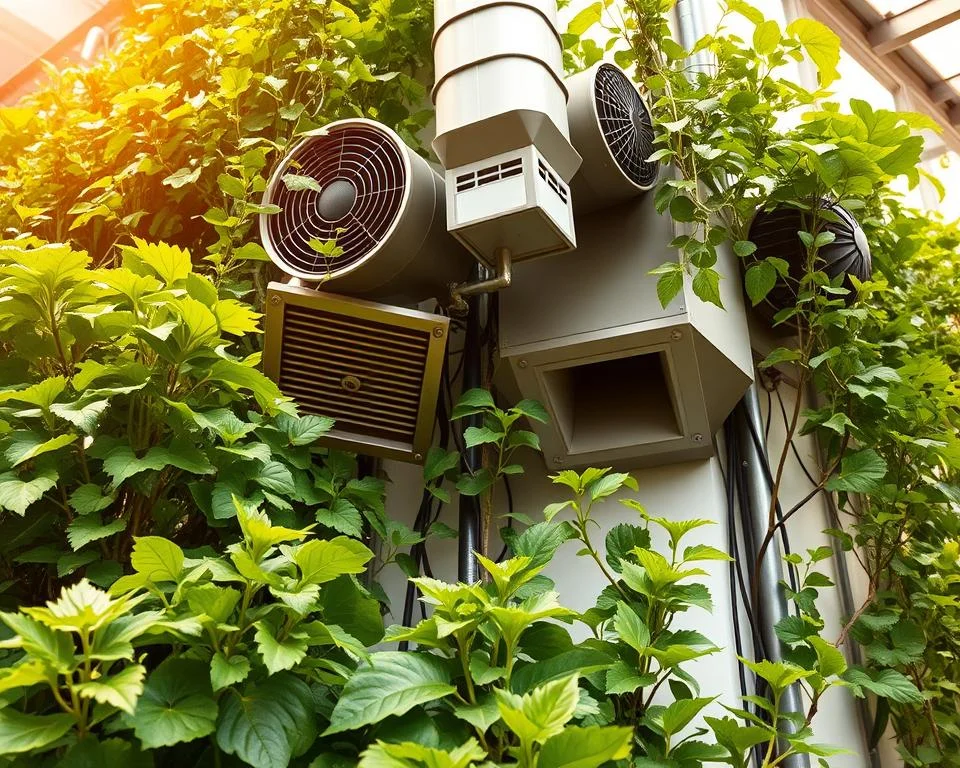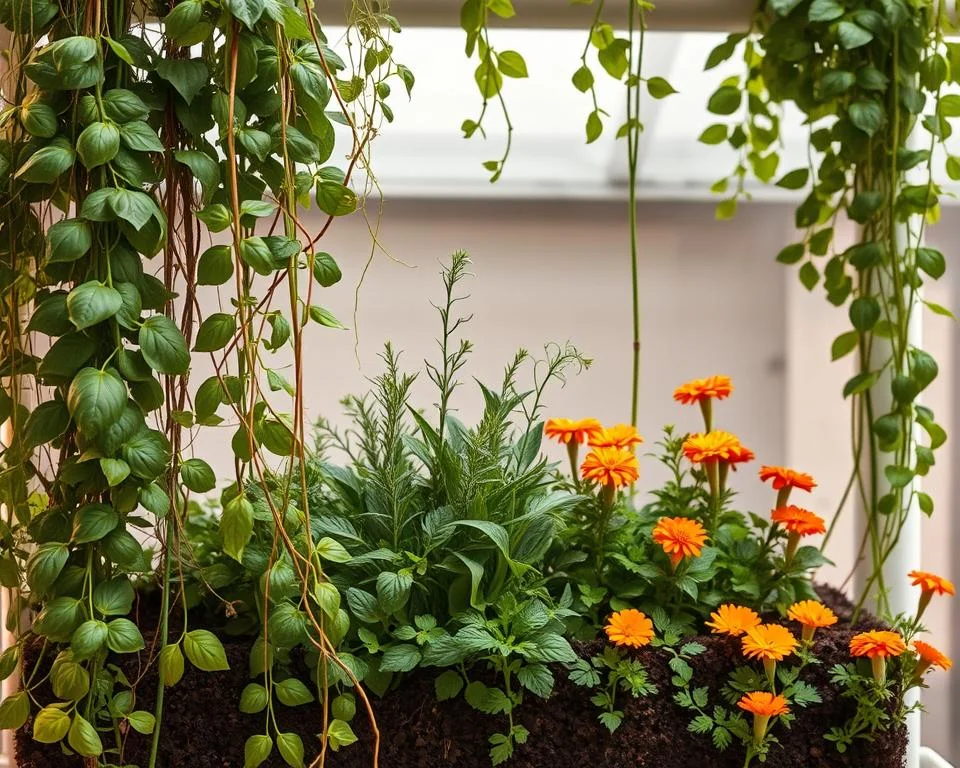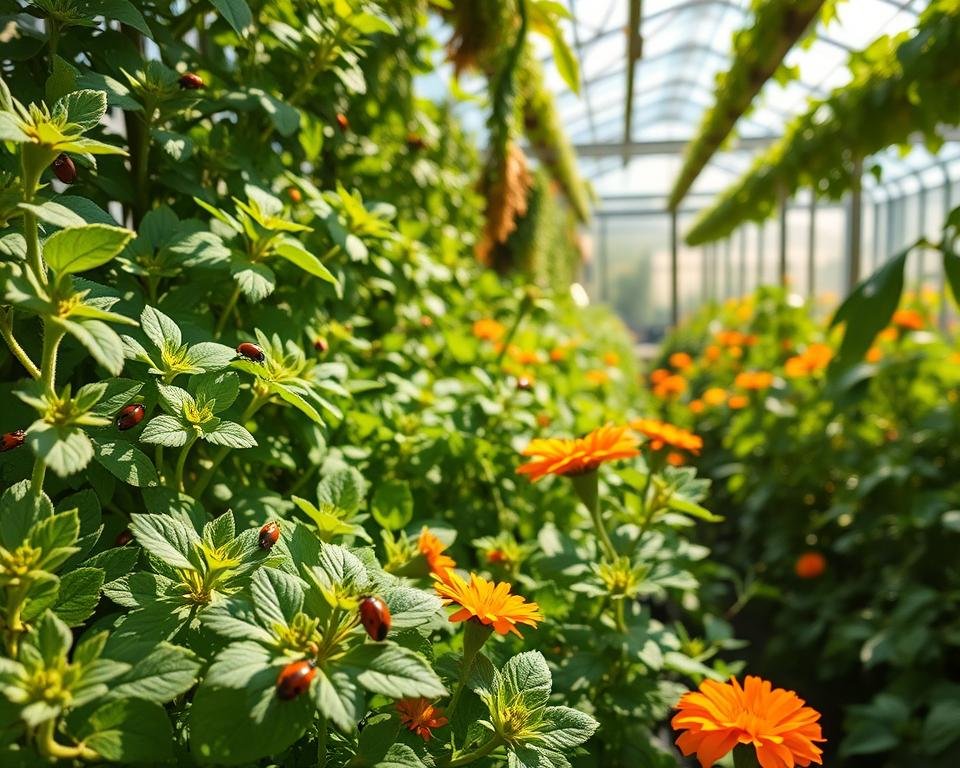Effective Pest Management Strategies for Vertical Gardens
Urban gardeners dream of turning blank walls into lush, vibrant vertical gardens. But, there’s a challenge: pest management is key to success. Your vertical garden is more than a decoration; it’s a delicate ecosystem that needs careful pest control.
Vertical gardens are not just pretty. They are complex systems where pest control is vital for plant health. By using proactive strategies, you can cut pest infestations by over 50%. This keeps your garden strong and beautiful.
To manage pests in vertical-gardens, you need a complete approach. Success comes from knowing environmental triggers, taking preventative steps, and acting fast when needed. Organic control and integrated pest management are your best tools for a thriving urban garden.
Key Takeaways
- Proactive pest management is essential for vertical garden health
- Organic control methods can significantly reduce pest populations
- Regular monitoring prevents extensive pest damage
- Environmental factors play a crucial role in pest prevention
- Integrated pest management offers comprehensive protection
Understanding Vertical Garden Pest Challenges
Vertical-gardens are a new way to grow food in cities, but they face special pest problems. It’s key to prevent pests and control them well to keep plants healthy in these small spaces.
Pests can grow fast in vertical gardens because they are small and have their own weather. Knowing these issues helps you plan a strong pest control plan.
Common Pest Types in Vertical Gardens
- Aphids: Tiny insects that multiply quickly in small spaces
- Spider mites: Tiny pests that love warm, dry places
- Whiteflies: Small flying bugs that can spread fast in vertical gardens
- Fungus gnats: Trouble in vertical gardens with lots of moisture
Environmental Factors Contributing to Pest Problems
| Environmental Factor | Pest Attraction Potential |
|---|---|
| High Humidity | Increases risk of fungal growth and insect reproduction |
| Limited Air Circulation | Creates ideal breeding conditions for pests |
| Consistent Temperature | Supports continuous pest life cycles |
Impact of Plant Selection on Pest Resistance
Choosing the right plants is very important for keeping pests away. Selecting naturally resistant varieties can greatly lower the chance of pests. Vertical farms often use little to no pesticides because they can keep pests out naturally.
“Integrated pest management is about creating a balanced ecosystem that naturally limits pest growth.” – Agricultural Research Expert
By understanding these challenges, you can take steps to manage pests in your vertical garden. This ensures your plants stay healthy and grow well.
Prevention Through Design and Planning
Designing your vertical garden with prevention in mind is key for long-term pest control. The pest management field is moving towards eco-friendly methods. These focus on sustainable pest prevention strategies. By using smart design, you can build a garden that keeps pests away naturally.
Your prevention plan should cover a few main points:
- Quarantine procedures for new plants
- Careful plant spacing
- Selecting pest-resistant growing mediums
- Incorporating natural pest deterrents
Organic pest solutions start with good garden design. Here are some key prevention tips:
- Start plants from high-quality seeds
- Create healthy, well-draining soil mixtures
- Install protective barriers
- Ensure proper air circulation
Prevention is always more effective and environmentally friendly than treating an established pest problem.
| Prevention Strategy | Effectiveness |
|---|---|
| Quarantine New Plants | High |
| Healthy Soil Management | Very High |
| Proper Plant Spacing | Moderate to High |
| Natural Pest Deterrents | Moderate |
By using these prevention methods, you can lower pest infestations and keep your garden healthy. Remember, a proactive approach is key to sustainable pest management.
Essential Air Circulation and Ventilation Systems
Good air flow is key to managing pests in vertical-gardens. The U.S. Environmental Protection Agency says indoor air can be 2-5 times dirtier than outside. This makes good ventilation crucial for keeping plants healthy and pests away.

Good air flow in your vertical garden helps keep pests away. Stagnant air is perfect for pests like aphids and spider mites.
Importance of Air Flow in Pest Prevention
Good ventilation stops pests by:
- Lowering humidity that pests like
- Stopping moisture buildup
- Making it hard for pests to reproduce
Ventilation Equipment and Setup
For pest control, your garden needs the right ventilation:
- Put in oscillating fans for constant air flow
- Use HEPA filters to catch 99.97% of tiny particles
- Think about adding HVAC for better climate control
Monitoring Air Quality Parameters
Keep an eye on air quality to spot pest problems early:
- Watch temperature
- Check humidity levels
- Look at airflow rates
- Monitor carbon dioxide levels
“Effective ventilation is the silent guardian of your vertical garden’s ecosystem.” – Vertical Gardening Experts
Keep your ventilation system in top shape. This will help protect your garden from pests, keeping it healthy and lively.
Pest Management Through Natural Methods

Natural organic control methods are strong alternatives to chemical pesticides in vertical-gardens. Your garden can become a self-regulating environment. It naturally manages pests through smart strategies.
Integrated Pest Management (IPM) is a key part of organic pest solutions. It focuses on prevention and minimal intervention. This reduces health and environmental risks from traditional pest control.
“Prevention is the first line of defense in maintaining a healthy vertical garden ecosystem.”
- Companion Planting: Strategic plant placement to repel pests
- Beneficial Insect Introduction: Ladybugs and lacewings as natural predators
- Homemade Organic Repellents: Using neem oil, garlic, and essential oils
Your organic control strategy should use many techniques. Biological controls like introducing predatory insects can greatly reduce pests. For example, ladybugs can eat up to 50 aphids a day. They are a great natural pest management solution.
Think about making your own organic pest solutions with simple ingredients:
- Garlic spray: Blend garlic cloves with water
- Neem oil mixture: Dilute with water and mild soap
- Essential oil repellents: Peppermint or rosemary based solutions
Regular monitoring is key in organic pest solutions. Check your vertical garden often. Look at leaf undersides and plant stems for early signs of pests. Prevention and early detection are vital for a healthy, pest-resistant garden ecosystem.
Integrated Pest Control Techniques
Vertical-gardens need smart pest management that’s more than just using chemicals. Integrated pest control is a full plan to keep plants healthy and cut down on harmful chemicals.

Keeping your vertical garden safe means knowing that most insects are good for plants. Only a tiny percent harm them. Most insects help keep the ecosystem in balance.
Biological Control Methods
Biological control is a key part of integrated pest control. It uses good bugs to fight off pests:
- Lady beetles eat aphids
- Predatory mites control bad insects
- Parasitic wasps target pests
Physical Barrier Solutions
Physical barriers stop pests without harsh chemicals. Here are some ways to do it:
- Put up fine mesh screens
- Use sticky traps
- Put on protective netting
Cultural Control Practices
Good pest management starts with keeping plants healthy. This makes them less likely to get pests.
| Practice | Pest Prevention Impact |
|---|---|
| Proper Watering | Reduces stress, increases plant resistance |
| Regular Pruning | Removes potential pest habitats |
| Sanitation | Eliminates breeding grounds |
*Chemicals should be the last resort in pest management, not the first line of defense.*
Effective integrated pest control needs ongoing watch and smart changes. By mixing biological, physical, and cultural methods, you can make your vertical garden strong.
Organic Solutions and Safe Treatments
Keeping your vertical garden safe from pests is easy with smart organic control. Most insects aren’t harmful, so you can manage them with natural solutions. This way, your plants stay healthy without harsh chemicals.
Effective organic pesticides offer many ways to manage pests. Here are some powerful natural treatments:
- Neem oil spray (2-4 tablespoons per gallon of water)
- Diatomaceous earth for ant and insect control
- Bacillus thuringiensis (Bt) for leaf-eating pests
- Insecticidal soap for fruit tree protection
“Nature provides the most effective pest management when we work with its systems.” – Organic Gardening Expert
Your vertical garden can greatly benefit from organic treatments. These target specific pests without harming your plants. Microbial pesticides like Bt are great for getting rid of caterpillars and beetle larvae.
| Organic Treatment | Target Pests | Application Method |
|---|---|---|
| Neem Oil | Aphids, Mites, Whiteflies | Foliar Spray |
| Diatomaceous Earth | Ants, Crawling Insects | Dry Powder Application |
| Bt | Caterpillars, Worms | Liquid Spray |
Using these organic pest solutions helps your vertical garden thrive. It also reduces harm to the environment. Regular checks and quick action are crucial for effective pest control.
Monitoring and Maintenance Protocols
Effective pest management in vertical gardens needs a proactive approach. By setting up systematic protocols, you can keep your plants healthy. This stops pests before they become a big problem.
Regular monitoring is key to preventing pests. Your vertical garden needs constant checks. This ensures you catch and deal with pests quickly.
Regular Inspection Schedules
Make a strong inspection plan for your vertical garden. Focus on:
- Weekly checks on plant health
- Bi-weekly pest inspections
- Monthly full garden reviews
Documentation and Tracking Methods
Keeping accurate records is vital for pest control. Here’s how to document your findings:
- Use digital apps or spreadsheets
- Log pest sightings, treatments, and results
- Track weather and other factors that affect pests
Early Warning Signs of Infestation
Know the early signs of pest problems:
- Discoloration or unusual spots on leaves
- Tiny holes or webbing on plants
- Unexplained wilting or slow growth
“Prevention is always more effective than cure in pest management.” – Vertical Gardening Expert
By following these monitoring and maintenance steps, you can make your vertical garden strong. This reduces pest risks and keeps your plants healthy.
Conclusion
Managing pests in your vertical garden needs a smart plan. Integrated pest management is a full solution, not just using chemicals. It helps you understand your garden’s ecosystem and protect your plants.
It’s not about getting rid of all insects. Instead, it’s about making your garden strong. Success comes from preventing pests, watching your garden closely, and using the right methods. Natural ways like introducing beneficial insects and using physical barriers help a lot.
Learning about pest control is a journey. Every garden is different, and you’ll need to change your approach. Keep learning, watch your garden closely, and be patient. This way, you’ll create a healthy garden that doesn’t get bothered by pests.
Your hard work in pest management makes your garden a success. Use these tips to improve your gardening skills. This way, you’ll have a garden that’s not only healthy but also strong against pests.







